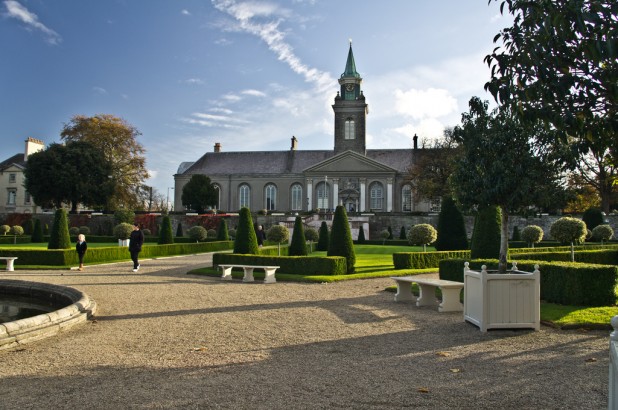
In 1545, the archbishop obtained a license to unite the Church of St. John the Baptist of Kilmainham and that of St. James, both without the suburbs, to the Church of St. Catherine, within the suburbs of Dublin.
In 1556, the Lord Lieutenant Fitzwalter kept his court at Kilmainham and it was here that he received the submission of Shane O’Neill.
In 1564, John Manne was appointed keeper of the King’s House in Kilmainham and, on his death in 1565, he was succeeded by Paul Greene ,who had a salary of twelve pence per day and a grant to him of the mansion house over the South Gate in Kilmainham, with a garden on the East side of the gate and the grazing of ten cattle, two horses and forty sheep, without any charge.
In 1680, King Charles directed the building of a hospital for the maintenance of aged and maimed soldiers, near the ruinous building commonly called the Castle of Kilmainham and that a quantity of land, not exceeding sixty four acres should be appropriated for ever, to its use. The foundation stone of the hospital was laid by the Duke of Ormonde and the building was completed in three years at a cost of approximately £23,559.00. The Chapel was consecrated in 1686 by the Archbishop of Dublin, assisted by the bishops of Kildare and Meath. It had accommodation for 400 men but only 200 men were in residence. Its inmates were well fed and clothed and were allowed eight pence per week as pocket money.
In the early 1760’s, the then Commander-in-Chief of Ireland, General Dilks, residing in the Royal Hospital, attempted to take over the burial ground and convert it into a botanic garden. He had the graves levelled, the area spread with lime and the entire area enclosed by a wall. The people of the Liberties, many of whom had family and ancestors buried there, gathered one night, knocked down the wall and opened the area for interment again. In 1832, during the cholera epidemic in Dublin, 3,200 burials took place in this churchyard, in a six month period, as it was the only free graveyard for the poor. The Board of Health, acting on the Lord Lieutenant’s order, directed that the cemetery be totally closed for a time and the newly consecrated burial ground at Grangegorman should be used instead. This prohibition was not lifted during the late 1800’s and the exclusion of the parochial rights of burial there was a source of discontent among the parishioners.
The Royal Hospital Kilmainham is now home to a modern art gallery.
IMAGE: The Royal Hospital Kilmainham, Dublin 8, Ireland – image credit: William Murphy/Flickr
Note from editor: This was originally published as part of our March 2011 ‘Fountain News’ digital newsletter, which we are re-publishing here. We have re-published it under the current date, because we think it remains relevant, plus it has been offline for a considerable amount of time.
 This article was originally published in:
This article was originally published in:
Fountain News Digital – March 2011 (Issue 3)
We are re-publishing all articles from our past newsletter, Fountain News Digital, and you can view all completed newsletters here. There were nine issues published in total between 2010 and 2012.









I am part of a team consisting of members from IMMA, OPW, DCC Archaeology, UCD Archaeology, Historic England working on a DCC commission of an accurate illustration of the Hospitallers Priory that once stood on the grounds of the Royal Hospital.
I have another date and names for your record of the keepers of Kilmainham from the journal of William Russell Lord Deputy 1594-1597.
“Dec 4th 1596 “This day Chambers died and his office for the keeping of Kilmanum my Lord bestowed on Mr. John Hoye who was married this day to Mrs. Grace Cade, my Lady’s Woman.”
check the facebook page – lost priory of the knights hospitallers kilmainham, for more posts.